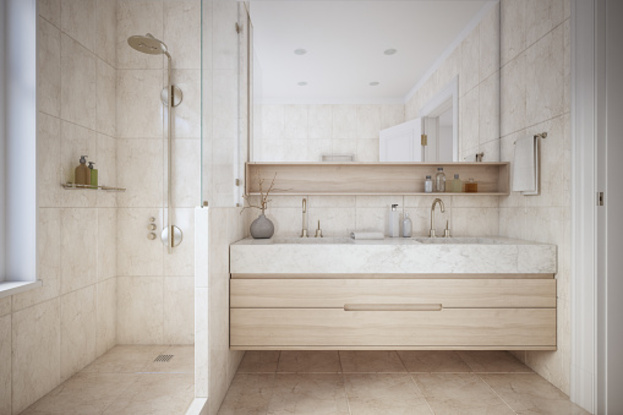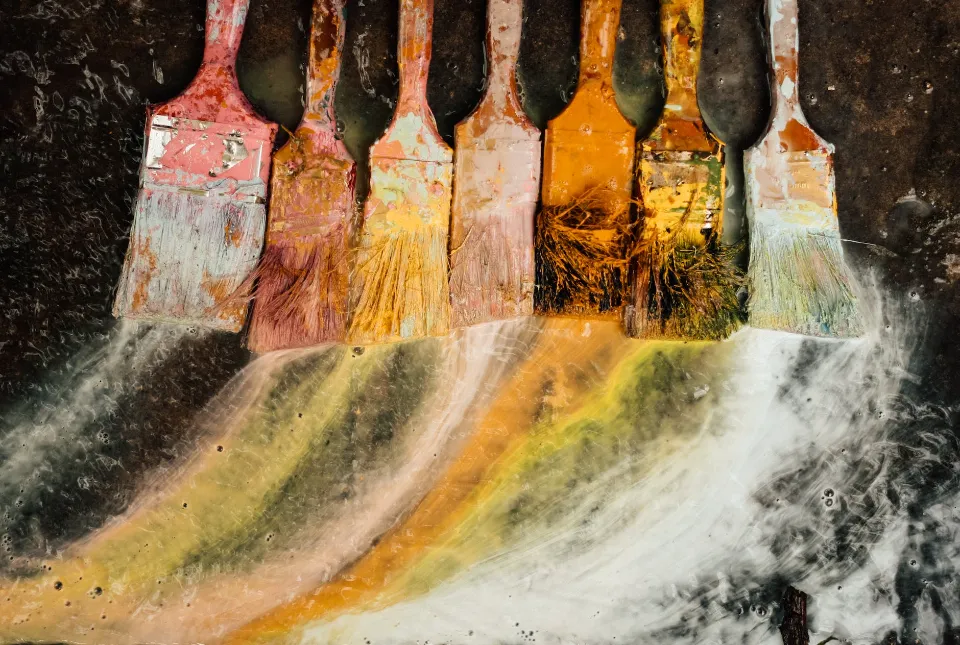Marble is strong, water-resistant, and ideal for use in bathrooms. The marble that has been sealed gains more stain resistance and cleaning convenience. Learn more about the necessary items in the following paragraphs to make sure your marble shower remains as stunning as the day you installed it.
Table of Contents
8 Useful Tips For Marble Shower Cleaning
1. Polish marble showers on the daily
According to The Spruce, cleaning your marble shower immediately after each use is the best way to maintain its appearance. But you don’t necessarily have to get on your hands and knees and scrub the shower clean.
Cleanipedia advises wiping the shower floor and tiles with a very soft rag or microfiber cloth after each shower. Verify that all of the products and water are gone. This should be done at least a few times per week, according to Granite Gold, who also advises deep cleaning your marble shower once per week.
According to Merry Maids, keeping up with the cleaning of your marble shower won’t just keep you safe from stains and mildew. According to the article, marble can start to deteriorate if soaps, hard water, or other products are left to sit on the surface. You’ll have issues beyond stains as a result.
2. Clean marble showers gently with water and neutral soap
Showers made of marble have a stunning appearance, but they are also very delicate. Use of regular soap or washing up liquid is therefore recommended for small cleaning tasks. A cloth and squeegee should always be accessible, suggests How To Clean Marble. Furthermore, if you want to use soap or detergent on your marble shower, they advise choosing one with a neutral pH. Simple Green explains that because marble is a soft stone, the pH of your products is crucial. Lemon, vinegar, and soaps with citrus notes are acidic; if they come into contact with the marble in your shower, they may erode and harm it.
To help the soap spread and clean the surface more evenly, wet the surface first before applying the soap. Once the marble has been cleaned, wipe it down and buff it to remove any remaining cleaner. After cleaning the shower, make sure that it is completely dry by not using abrasive sponges.
3. Use mold and mildew remover made for marble showers
If they’re not properly cleaned and maintained, marble showers, like any other showers, can develop mold and mildew. According to Love To Know, you can use mold and mildew remover in your marble shower, but it must be a formula made especially for the porous natural stone.
According to The Marble Cleaner, you’ll need your specially formulated product, a soft cloth, a toothbrush or soft-bristled brush, and water to get rid of mold or mildew without harming your marble shower. Apply the mold and mildew remover, then leave it there for five to ten minutes. Following ten minutes, very gently scrub the area with your toothbrush. Once you’ve removed as much of the mold or mildew as you can, clean and dry the area with a soft cloth after using warm water to spray or run over it.
4. Scrub marble showers with baking powder and water
Consider making a homemade stain-busting mixture out of baking soda and water if you’ve noticed more noticeable stains in your marble shower. Marble is a common choice for bathrooms because your shower won’t be subjected to the same kinds of stains that it would be in the kitchen, according to Stephanie Laney, lead designer for Surfaces USA, who spoke to Forbes. That does not mean that stains can be completely avoided, though. According to Tile Club, a targeted approach is necessary when dealing with large stains.
Make sure your shower is completely dry before misting the stained area with water. Baking powder and water should be combined in a bowl to form a thick paste. Make sure to apply a thick, even layer of paste to the stain as you spread it out. For 24 hours, wrap plastic wrap over the stain and let it sit. Make sure everyone in your home is aware they shouldn’t use the shower during this time. You can take off the plastic wrap after 24 hours and use a soft cloth to remove the solution. You can try it again if the stain is still there.
5. Use hydrogen peroxide to clean marble showers
Many experts recommend that you use extreme caution when applying more potent cleaning agents to the surfaces of your marble shower. But according to The Spruce, 12% hydrogen peroxide might be the key to removing stubborn stains. A soft cloth or paper towel should be dipped in 12% hydrogen peroxide, according to the publication. While doing this, make sure your hands are protected. A minimum of 20 minutes should pass after placing the wet towel on the stain. You can use tape to secure it or weight it down if you’re concerned that it’ll move. Lift the towel or cloth after ten minutes. You should try again with more hydrogen peroxide and a fresh cloth if the stain doesn’t come out. You can rinse the area, clean it up, and buff it dry if it has vanished.
Clever reports that the Marble Institute has given 12% hydrogen peroxide with a dash of ammonia their seal of approval, despite the fact that you might be hesitant to use chemicals on your marble shower. If you use dry body oil or hair oil while taking a shower, this could aid in stain removal because these solutions work particularly well on oily stains.
6. Steel wool can help clean marble showers
When looking for advice on how to clean marble, it’s highly likely that every piece of knowledge you come across will fairly explicitly advise against using hard or abrasive cleaning materials. However, How To Clean Marble reveals that very fine steel wool might be your only option if you are having trouble eliminating mineral buildup or water stains. The minerals in a standing water in your marble shower can accumulate and leave stains. If you reside in a region with hard water, this is especially true.
Handle your marble shower with extreme caution if you want to successfully remove water stains with fine steel wool. Use a soft cloth to make sure the surface is completely dry before using a gentle scrubber to carefully remove the stains. Don’t scrub too vigorously, and stop immediately if you hear the marble scratching.
7. Use cornstarch to cleanse marble showers
You can remove stains from the surface of your marble with corn starch, another incredibly simple cleaning tip that uses a product that is probably already in your kitchen cabinet. According to Cleanipedia, corn starch is particularly effective at removing greasy or oily stains. It is best to make an effort to remove these stains as quickly as possible after they appear.
According to the publication, you should generously sprinkle corn starch over the stain, making sure to spread it out evenly. Allow the corn starch to sit for twenty to thirty minutes. With a damp cloth, remove the corn starch, and then buff the surface dry.
According to Cleanipedia, you can leave the corn starch solution on the stain for up to 24 hours before wiping it away if you see that it persists. Your marble will receive a much deeper clean as a result.
8. Call in the experts to clean marble showers
Although you can certainly clean marble yourself, there are times when it is preferable to seek the advice of a professional. It is a very delicate rock, and Better Homes & Gardens explains that using the wrong product or neglecting to keep your marble shower clean could result in permanent surface damage.
You might need a professional’s assistance if your marble shower has a dark stain or if you have scratched the surface. According to Surfaces USA’s lead designer Stephanie Laney, the role that sealant can play in making it easier to clean your marble is crucial. “Sealers are like buying time,” she told Forbes. “It seals the marble’s top, preventing quick penetration.”
The Spruce advises sealing your marble shower as soon as it is installed to protect it. You can either do the shower’s resealing yourself from that point forward or hire a professional to do it. Clever advises doing this every few months.

How To Clean A Marble Shower Daily
Get Rid Of Water Drops
Use a microfiber cloth or a squeegee to clean the shower walls after each shower, beginning at the top and moving downward. Soap scum forms on the surface as a result of water drops standing on the walls and the body oils and bath product residue they hold. Daily drying will also aid in preventing the development of mold and mildew, which can leave stains on surfaces permanently.
Tip
You may only need to deep clean your shower once a month if you consistently dry the shower stall after each use and use the bathroom fan to remove moisture from the air.
How To Clean A Marble Shower Weekly
Create A Cleaning Solution
One teaspoon of a mild dishwashing liquid should be added to a spray bottle of very warm water. Choose a pH-neutral dishwashing liquid that doesn’t contain dyes or any acidic ingredients like lemon or vinegar, and shake well to combine.
Your shower can be cleaned using a commercial marble cleaner as well. Regarding dilution and usage, adhere to the instructions on the product label. Avoid using any popular spray-on bathroom cleaners that contain chlorine bleach or acidic ingredients.
Spray And Wipe
Spray the solution on the walls, floor, and any other surfaces that have marble (such as the surround), working your way from the top of the shower to the bottom. Wipe the surfaces with a microfiber cloth in a circular motion, paying close attention to the region around fixtures and drains that is more vulnerable to mildew stains.
Rinse Well
Fresh water should be used to wash down the walls using a bucket or a handheld shower head. Once more, begin at the top and work your way down to the ground. To achieve a polished marble surface, every trace of soapy residue must be rinsed away.
Dry And Buff
Remove every last drop of water from the shower’s walls and floor using a squeegee or a soft microfiber cloth. As a final step, buff the marble with a dry microfiber cloth. To polish every surface, move in broad circles.
Tackle Tough Stains
There are several things you can try if the general cleaning did not completely get rid of the stains. Never use chemicals that are harsh!
Hard water build-up: Use superfine No. 001 steel wool if the shower has mineral buildup around the fixtures or drains and you haven’t cleaned it frequently. 0000 steel wool to gently buff away the deposits. To avoid scratching the marble, move slowly and with a light touch.
Discoloration from bath products: Put fresh 12 percent hydrogen peroxide on a white microfiber cloth or paper towel and let it soak in. Ten minutes should pass after placing the cloth over the stain. If the stain is gone, rinse the area thoroughly, pat it dry, and then buff it to a shine. Repeat the hydrogen peroxide soak if the stain is still present. When you apply hydrogen peroxide to a surface, it should bubble a little to indicate that it is new and active.
Mold and mildew: Use only products that have been approved for marble. Utilize only non-chlorine bleach.
How Often To Clean A Marble Shower
After each use, a marble shower stall should be cleaned to remove extra water, body oils, and cosmetic residue.
Plan to perform a more thorough cleaning twice a week to keep the marble looking its best and to help with any mildew growth or stains.
Tips To Keep Marble Showers Clean Longer
- Select bath products free of dyes and other acidic or corrosive substances that can permanently discolor skin. Avoid using any commercially available acid-based cleaners, including those that are suggested for granite, or any homemade concoctions that contain distilled white vinegar or lemon juice.
- Useless cleaning equipment with stiff bristles can damage marble permanently.
- Abrasive cleaning agents that can etch the marble surface, such as ammonia or chlorine bleach, should be avoided.
- In areas of the nation where the water is hard, marble should be dried or squeegeed because marble adheres to calcium and magnesium carbonates more firmly than any other bathroom tile.
- Re-sealing the marble is necessary if water no longer beads up on its surface or if a wet shower appears darker. You or a professional can reseal using a commercial sealant.





